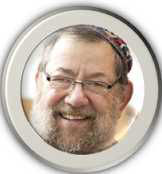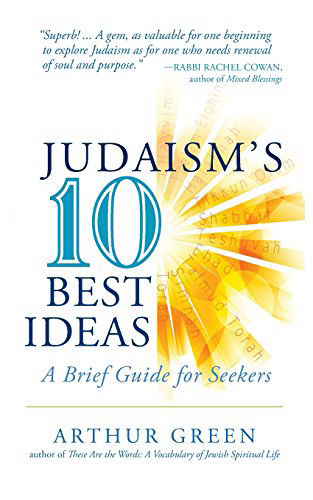Judaism’s 10 Best Ideas
(A Brief Guide for Seekers)
By Arthur Green

Dr. Arthur Green
About Dr. Arthur Green: He was trained at the Masorti Conservative Rabbinical Seminary, JTS in New York City. In 1984 he became dean, and then president, of the Reconstructionist Rabbinical College in Philadelphia. He has written at least 20 books and is considered one of the foremost experts on Jewish mysticism and Neo-Hasidic theologian. He was a founding dean of the non-denominational rabbinical program at Hebrew College in Boston, where he still teaches. He visited St. Louis in September of 2019 for a memorable and very appreciated Scholar-in-Residence weekend.
In 2014 professor Arthur Green published this small compendium that you can get through in a couple of hours but will have a long lasting impact.
In ten short chapters, Dr. Green selects the ten most crucial Jewish ideas, their background, their meaning and their impact on the world today.
The first “Best Idea” is “Simhah, Joy, Happiness as a religious precept”. It may be a surprise to some that Simhah is selected as number one, but as Dr. Green writes, “imagine a religion that begins with God wants you to be happy. As it is written: “Serve YHWH with joy”. In the daily Kedushah the angels encourage you to be happy. He writes that (as opposed to other religions) “too much concern about ‘sin’ puts you in mortal danger”. The great founder of Hasidism, Rabbi Israel Ba’al Shem Tov said that the forces of evil trick you into be overly worried about the smallest sins, which takes away from your joy. Performing a Mitzvah is meant to fill your heart with joy.
Second: ”Tzelem Elohim, Creation in God’s Image, What Are We Doing Here?”. The verse in Bereishit about God creating man in God’s image is one of the most discussed verses in all of Judaism. What does it mean? Of the many meanings the study of Judaism offers, Dr. Green emphasizes the fact that Jewish people consistently have led the fight for civil and human rights, environmental justice, among others, and that this is a reflection of our having been created in God’s image.
Third: “Halakhah - Walking the Path, A community of Doers”. The word Halakhah literary means “walking”, or “path” or “a way of walking”. In Devarim, Moses urges the people to “walk in God’s ways”. This is important, explains Dr. Green, “because the Jewish community defined itself around a pattern of behavior, it did not need to define itself by spelling out all the norms of theological orthodoxy” In other words, how you behave is more important than what you believe. One may say it as follows: It’s a matter of deed over creed.
The fourth idea is “Tikkun Olam, Repairing the World. Being God’s partner." For us this means ”relieving human suffering achieving peace … and protecting the planet itself from destruction.” We are partners with God in creation and therefore bear a responsibility to our fellow humans and to the earth.
Shabbat is fifth idea: “Getting off the treadmill. The secret of Shabbat”. Dr. Green asks why this commandment – observing and remembering the Sabbath – “became such a defining trait of a citizen in good standing in the world of Jewish piety”. Why not something else-, dietary rules, believing in God, helping the poor? In the old days, Shabbat was looked upon as a list of “don’ts.” Today is different: Our lives have been accelerated up by technology and the pace is so frantic that our parents and grandparents could not have imagined it.
Second: ”Tzelem Elohim, Creation in God’s Image, What Are We Doing Here?”. The verse in Bereishit about God creating man in God’s image is one of the most discussed verses in all of Judaism. What does it mean? Of the many meanings the study of Judaism offers, Dr. Green emphasizes the fact that Jewish people consistently have led the fight for civil and human rights, environmental justice, among others, and that this is a reflection of our having been created in God’s image.
Third: “Halakhah - Walking the Path, A community of Doers”. The word Halakhah literary means “walking”, or “path” or “a way of walking”. In Devarim, Moses urges the people to “walk in God’s ways”. This is important, explains Dr. Green, “because the Jewish community defined itself around a pattern of behavior, it did not need to define itself by spelling out all the norms of theological orthodoxy” In other words, how you behave is more important than what you believe. One may say it as follows: It’s a matter of deed over creed.
Shabbat is fifth idea: “Getting off the treadmill. The secret of Shabbat”. Dr. Green asks why this commandment – observing and remembering the Sabbath – “became such a defining trait of a citizen in good standing in the world of Jewish piety”. Why not something else-, dietary rules, believing in God, helping the poor? In the old days, Shabbat was looked upon as a list of “don’ts.” Today is different: Our lives have been accelerated up by technology and the pace is so frantic that our parents and grandparents could not have imagined it.
Because of that, Shabbat is needed now, more than ever.
“We Jews should be missionary about Shabbat,” writes Dr. Green, “It may be the best gift we have to offer the world!” Shabbat is, as Rabbi Abraham Joshua Heschel observed, “a palace in time”.

The sixth idea is Teshuvah, Returning. Faith in human change” The idea of teshuvah counsels, repentance, returning to God. The concept of second chances and our ability to “come around,” originates in Judaism. And it is central to our daily liturgy and a centerpiece of the Yom Kippur service. Quote: “For harm done to another person repenting to God does not suffice.”
Number seven is: “Torah. The People and the Book. Text and Interpretation.” Questions regarding when Whenever the Torah was written and by whom are not as important as the concept and tradition of interpretation, which began long before Ezra’s time. “Freedom of interpretation became the lifeblood of Jewish creativity.” “Judaism has never been fundamentalist in terms on how to read the biblical texts,” Dr. Green argues.
Number eight is “Talmud Torah. Teach Them to Your Children. The Role of Education.” Dr. Green maintains that the single most important precept of Judaism can be found in Devarim,(Deuteronomy) 6:7, “You shall teach them diligently to your children.” The commandment to educate, to pass along the legacy is crucial. We are passing the torch. To be a “Ben Torah” a person of learning was an early and crucial aspiration.
The Chavruta, the study partnership, is highly valued in Judaism and denotes a special kind of friendship
Also, wisdom was always seen as cumulative, with each generation of students and scholars standing on the shoulders of all those who came before. But education is not exclusively for the young. Many congregations offer adult education and espouse lifelong learning in order to enhance Jewish literacy.
The ninth precept is: “L’HAYYIM To Life! Accepting Death, Affirming Life”
God’s commandments as set forth in Vayikra (Leviticus) are commandments “to live by” (18:5). Talmud instructs that this means that we need to live for them rather than die for them.
Human life is considered sacred. Saving a single life is akin to saving the entire world, says the Talmud. And life means “in this life.” The only place to serve God is here on earth, and nowhere else. Talmud also teaches: “Greater is one hour of fulfilling commandments and doing good in this world than all the life of the World to Come.” One can clearly say: “Message received.”
Dr. Green's number ten (although there is no ranking), puts last that which som might have put first: "Ehad, Hear O Israel. There is Only One.” The Shema, the cornerstone of “prayers” is, properly speaking not a prayer at all!
This chapter is the most convincing of the ten, in this reviewer’s mind. What is monotheism? What difference has it made? God bestowed God’s own grace on every creature that would ever exist. “Therefore - and this is the key line, the only one that really counts – treat them (others) that way. They are all God’s creatures – just as you are.”
Dr. Green goes on to expound upon the name Y-H-W-H and its many meanings.
In his six-page appendix Dr. Green includes suggestions for further studies, - a welcome addition given that his book serves an “appetizer” of sorts.
This book, can be found online, for instance at AbeBooks. Both new and used copies are available.
Also, the Kol Rinah Verein Group held a book discussion: July 12, 2020 at 4 PM on Zoom. For more details, see the Kol Rinah Web site
Richard Gavatin
Number seven is: “Torah. The People and the Book. Text and Interpretation.” Questions regarding when Whenever the Torah was written and by whom are not as important as the concept and tradition of interpretation, which began long before Ezra’s time. “Freedom of interpretation became the lifeblood of Jewish creativity.” “Judaism has never been fundamentalist in terms on how to read the biblical texts,” Dr. Green argues.
Number eight is “Talmud Torah. Teach Them to Your Children. The Role of Education.” Dr. Green maintains that the single most important precept of Judaism can be found in Devarim,(Deuteronomy) 6:7, “You shall teach them diligently to your children.” The commandment to educate, to pass along the legacy is crucial. We are passing the torch. To be a “Ben Torah” a person of learning was an early and crucial aspiration.
The Chavruta, the study partnership, is highly valued in Judaism and denotes a special kind of friendship
Also, wisdom was always seen as cumulative, with each generation of students and scholars standing on the shoulders of all those who came before. But education is not exclusively for the young. Many congregations offer adult education and espouse lifelong learning in order to enhance Jewish literacy.
The ninth precept is: “L’HAYYIM To Life! Accepting Death, Affirming Life”
God’s commandments as set forth in Vayikra (Leviticus) are commandments “to live by” (18:5). Talmud instructs that this means that we need to live for them rather than die for them.
Human life is considered sacred. Saving a single life is akin to saving the entire world, says the Talmud. And life means “in this life.” The only place to serve God is here on earth, and nowhere else. Talmud also teaches: “Greater is one hour of fulfilling commandments and doing good in this world than all the life of the World to Come.” One can clearly say: “Message received.”
Dr. Green's number ten (although there is no ranking), puts last that which som might have put first: "Ehad, Hear O Israel. There is Only One.” The Shema, the cornerstone of “prayers” is, properly speaking not a prayer at all!
This chapter is the most convincing of the ten, in this reviewer’s mind. What is monotheism? What difference has it made? God bestowed God’s own grace on every creature that would ever exist. “Therefore - and this is the key line, the only one that really counts – treat them (others) that way. They are all God’s creatures – just as you are.”
Dr. Green goes on to expound upon the name Y-H-W-H and its many meanings.
In his six-page appendix Dr. Green includes suggestions for further studies, - a welcome addition given that his book serves an “appetizer” of sorts.
This book, can be found online, for instance at AbeBooks. Both new and used copies are available.
Also, the Kol Rinah Verein Group held a book discussion: July 12, 2020 at 4 PM on Zoom. For more details, see the Kol Rinah Web site
Richard Gavatin